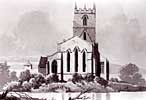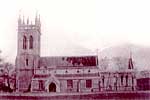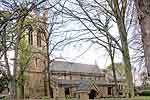For this church:    |
|
 View
of the church in 1831 View
of the church in 1831showing the narrow north aisle |
At the beginning of the 18th century the church had deteriorated so badly a Church Brief was granted. At his Visitation in May 1718 the Archdeacon recommended repairs to ‘ye Outwalls Windows and Pavement where wanting and white-washed all over within.’ Four years later he said the walls should be pointed, windows mended and a cover provided for the font. A new north aisle was built about then, shown in the 1831 painting. In 1813 Stretton said the cancelli remained although the upper part had been plastered over for the King’s Arms (George III) c1760. The floor was damp, the seats rotting. In 1818/19 repairs were undertaken and a gallery installed in the south aisle and across the west end. Edward Staveley, a prominent Nottingham architect, surveyed the church and estimated the cost of new box pews, pulpit, reading desk, clerk’s desk, gallery, raising the floor and repairing walls to be £850. A grant of £200 was obtained from the Incorporated Church Building Society, which insisted on 170 new free sittings, but £400 had to be borrowed.
Basford was enclosed in 1792 when the tithes were commuted for land worth £120 p.a. By 1831 the value was £260 including 150 acres of glebe land, nearly all of which had been sold by 1902, much of it as the site for Bagthorpe Workhouse.
In the 1850s the church was again in a delapidated state, the walls bad and the roof letting in rain. Architect George Place of Nottingham prepared a report on the condition of the building and proposals for restoration. The Nottinghamshire Guardian (23 April 1857) summarised the report:
‘The plan of the church consists of a long chancel, a nave of five bays, north and south aisles, a west tower, and south porch. The prevailing style is first pointed, but the upper part of the tower and the south aisle are later. The tall lancet windows of the chancel and the clustered columns of the nave arcades are particularly handsome. The ancient high roofs have been removed and perfectly flat ceilings occupy their places - of course much to the disfigurement of the general interior. These roofs too, are much decayed, and require to be replaced by new ones. Another disadvantage to the interior has been the raising of the floor about 18 inches above its former level. The tower is divided from the body of the church by a small singing gallery, and a vestry is provided out of the west end of the south aisle. A complete system of pews fills up the interior, some of them square and no centre passage is provided up the middle of the church. It is now proposed to increase the accommodation from 420 to 800 worshippers, by reseating the interior, and by rebuilding and enlarging the north aisle. The tower is to be repaired, and new high roofs placed upon the church. A new north porch is to be built, and a vestry provided at the east end of the north aisle. The church is to be heated by hot air, and a bed of concrete laid under the floors against the damp. The masonry generally is to be restored, and the church-yard properly drained.’
The ICBS again made a grant - of £180 - towards restoration, overseen firstly by Place who went bankrupt, then by his partner W. A. Wilson. The work was done by W. Garland of Nottingham and W. Lee of Retford. It was almost ready to re-open in April 1859 when the tower collapsed bringing with it much of the recently restored west end. The ICBS refused to send an architect to examine the ruin so the Rev H. R. Pitman appointed Thomas Allom, the well-known London architect, to design the distinctive new tower which adorns the church today.
On 1st March 1860 the church was re-opened after drastic alterations. Besides the tower the flat roofs had been raised to a steeper pitch, there was a new north aisle, north porch, organ chamber and clerestory, and the west end of the nave and the south aisle had been re-built. Galleries were removed and the box pews replaced by open benches, some of which are still at the back of the nave. The church had been closed for almost two years, the schoolroom being used for services, although ‘the least attached members of the congregation are fading away’, said the Rev H. R. Pitman.
Some of them may well have begun to attend one of several very popular non-conformist chapels in the area. The Methodist New Connexion and the General Baptists erected chapels pre-1800; in 1793 Robert Hall, the textile manufacturer, built a chapel in the grounds of Basford Hall for his employees. The Wesleyan Methodists put one up in c1805, the Primitive Methodists had a large room and the Scotch Baptists erected a chapel on Pepper Street in 1826. There was plenty of competition for the souls of Basford. By 1879 G. Mabbs wrote that St Leodegarius had 800 seats - compare the 1851 Religious Census figure of 525 - but the non-conformists could provide 876. At that Census 153 worshippers attended church in the morning and 190 in the evening. The Rev T. A. Bolton, first vicar of St Augustine, New Basford, had opened a licensed room on Pepper Street in 1848 but said the area was ‘abounding with almost all kinds of heresy.’
 The church after The church after the fire in 1900 |
Tragedy stuck the church again in 1900. Restoration work on the building, including re-roofing the whole of the nave and chancel, was almost complete when a fire broke out on 29th November, destroying the chancel roof, interior fittings, stained glass windows, and organ. Restoration began immediately, carried out largely at the expense of the Duke of Newcastle, and comprised 're-roofing, a new altar screen, altar, lectern, choir stalls, altar rails, clergy vestry, canopy to font, oak pannelling on the walls, stained glass windows, and a new organ.' A new floor was laid and the new vestry built by W. H. Thompson of London, the walls were panelled in oak and chairs replaced most of the benches. The vicar’s daughter Janetta added tasteful murals in the chancel. The church was closed for 18 months and re-opened on 24th April 1902.
Sadly, the Rev H. R. Pitman died the day before; he had been at the helm for 53 years. He had lived in three rented houses, two on Church Street then on Radford Road near the gas works, until he built a large vicarage in 1882, overlooking the cemetery on Nottingham Road. (It was demolished in the mid-1960s.) A vicarage was built originally in 1226, and a house mentioned often in the 16th and 17th centuries, but by 1743 the vicar, Thomas Beaumont, said there was no parsonage nor had been in his time. The present vicarage is on Perry Road.
For many years Pitman had to provide a curate for Christ Church, Cinderhill, erected as a chapel of ease to St Leodegarius in 1855/56. Before that he held services for the miners in a small room at the side of the Red Lion Inn. Both his sons served as curate of Cinderhill before joining the Royal Navy as chaplains. Cinderhill did not become a separate District until 1896, when the Bishop of Southwell began to provide the curates. (St Aidan was formed as a parish from St Leodegarius in 1910).
We have a detailed account of the Vicars of Basford. John Sympson, also vicar of Radford, was often in trouble in the archdeacon’s court; in 1574 and 1592 he was accused of letting his ‘vicaredge house’ decay, and in 1593 and 1594 he was excommunicated. Matthew Hickman was indicted for drunkenness in July 1629 and in October ‘for letting his vicarage house goe to decaye and part thereof fall downe,’ and was charged with ‘going forth of our town and not leaving one to read divine service’ on 25th October 1629. Basford had no vicar from about 1663 to 1682 but had a curate who acted as sequestrator. Following the Act of Uniformity in 1662 Basford became a stronghold of non-conformity.
Robert Stanser was one of the most interesting vicars, during his 53 years in charge from 1759. He lived in the parish, was conscientious and even instructed a few gentlemen in his own house. In 1770 he was made a burgess of Nottingham and in 1778 he was appointed domestic chaplain to the Earl of Abingdon. He had the north aisle re-built and the churches in his other parishes of Bulwell and Edwalton were greatly improved in his time. By contrast Thomas Hosking, vicar from 1818 to 1840, hardly ever came to Basford. In 1832 Archdeacon Wilkins wrote to him ‘that as the parish is in a most deplorable state and the spiritual concerns there have been grossly neglected’ he would remedy them ‘by placing a clergyman of zeal and activity in the parish.’ Thus Robert Simpson was installed. He was only at Basford for seven years but made many improvements, including a new burial ground. It was to be expected from the man who, in 1836, published a pamphlet entitled ‘State of the Church in the County of Nottingham with hints for its Improvement.’
Henry Rogers Pitman was also vicar for 53 years, from 1848. His struggles to get the church repaired after the tower collapsed in 1859 and after the fire in 1900 are well documented. His poverty and his long struggle to get a vicarage built are not so well known. Until 1882 he had to live in an ordinary house for which he had to pay a licence. He wrote to the Bishop of Lincoln in March 1864, ‘It seems hard that I have to pay a tax for not having a house [ie vicarage] - that being poor I am to be made poorer still. The world and the Church are widely different over this, the World makes you pay for having an income, the Church because one hasn’t.’
The church hall was opened in 1905 on a site on Nottingham Road (opposite Perry Road) given by Sir Charles Seely. It soon proved inadequate so two ‘handsome’ rooms were added in 1910. A sum of £60,000 was spent on repairs etc. in 1978-81. On 3rd March 1996 the Bishop of Southwell conducted a Service of Dedication of St Leodegarius’ Congregation in the church hall, which was used for some services for a few years.
In recent years vandals have been a major problem. The recently decorated church was broken into on Easter Monday, 1974, and the organ, organ screen and music were destroyed by fire. A new organ from Messrs J. W. Walker was installed and the cost of restoration was covered by insurance and generous gifts. It was the third time in ten months that the church had been vandalised. In October 1980 lead was stolen from the church roof for the fourth time in three years.
The new kitchen and toilet facilities in the base of the tower were dedicated on 8th September 1995.
Relevant Dates
1086Priest and possibly church
c1175Cistercian Priory at Catesby endowed from Basford church
1219First named vicar William
Late C12Re-built
Early C14Lady Chapel added
1818/19Repairs and alterations
1858Restoration work begins
1859Collapse of tower
1860New tower and other additions
1900Fire followed by restoration
1974Fire followed by restoration






